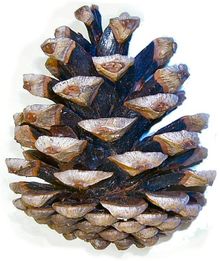AlexisSilverstein.com
Artist
Artist
Your Subtitle text
Pine Cones
Credit goes to Wikipedia for this pine cone information
The members of the pine family (pines, spruces, firs, cedars, larches, etc.) have cones that are imbricate with scales overlapping each other like fish scales. These are the "archetypal" cones. The scales are spirally arranged in fibonacci number ratios.
The female cone has two types of scale: the bract scales, derived from a modified leaf, and the seed scales (or ovuliferous scales), one subtending each bract scale, derived from a highly modified branchlet. On the upper-side base of each seed scale are two ovules that develop into seeds after fertilisation by pollen grains. The bract scales develop first, and are conspicuous at the time of pollination; the seed scales develop later to enclose and protect the seeds, with the bract scales often not growing further.
The scales open temporarily to receive pollen, then close during fertilization and maturation, and then re-open again at maturity to allow the seed to escape. Maturation takes 6–8 months from pollination in most Pinaceae genera, but 12 months in cedars and 18–24 months (rarely more) in most pines.
The cones open either by the seed scales flexing back when they dry out, or (in firs, cedars and golden larch) by the cones disintegrating with the seed scales falling off. The cones are conic, cylindrical or ovoid (egg-shaped), and small to very large, from 2–60 cm long and 1–20 cm broad.
After ripening, the opening of non-serotinous pine cones is associated with their moisture content—cones are open when dry and closed when wet.
[1] This assures that the small, wind disseminated seeds will be dispersed during relatively dry weather, and thus, the distance traveled from the parent tree will be enhanced. A pine cone will go through many cycles of opening and closing during its life span, even after seed dispersal is complete.
[2] This process occurs with older cones while attached to branches and even after the older cones have fallen to the forest floor. The condition of fallen pine cones is a crude indication of the forest floor's moisture content, which is an important indication of wildfire risk. Closed cones indicate damp conditions while open cones indicate the forest floor is dry.









